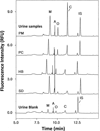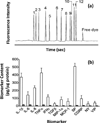Clinical applications of capillary electrophoresis based immunoassays
- PMID: 24132682
- PMCID: PMC3975666
- DOI: 10.1002/elps.201300421
Clinical applications of capillary electrophoresis based immunoassays
Abstract
Immunoassays have long been an important set of tools in clinical laboratories for the detection, diagnosis, and treatment of disease. Over the last two decades, there has been growing interest in utilizing CE as a means for conducting immunoassays with clinical samples. The resulting method is known as a CE immunoassay. This approach makes use of the selective and strong binding of antibodies for their targets, as is employed in a traditional immunoassay, and combines this with the speed, efficiency, and small sample requirements of CE. This review discusses the variety of ways in which CE immunoassays have been employed with clinical samples. An overview of the formats and detection modes that have been employed in these applications is first presented. A more detailed discussion is then given on the type of clinical targets and samples that have been measured or studied by using CE immunoassays. Particular attention is given to the use of this method in the fields of endocrinology, pharmaceutical measurements, protein and peptide analysis, immunology, infectious disease detection, and oncology. Representative applications in each of these areas are described, with these examples involving work with both traditional and microanalytical CE systems.
Keywords: Affinity capillary electrophoresis; CE immunoassay; Capillary electrophoresis; Clinical chemistry; Immunoassay.
© 2013 WILEY-VCH Verlag GmbH & Co. KGaA, Weinheim.
Figures











References
-
- Tietz NW, editor. Textbook of Clinical Chemistry. Philadelphia: Saunders; 1986.
-
- Clarke W, editor. Contemporary Practice in Clinical Chemistry. 2nd ed. Washington, DC: AACC Press; 2011.
-
- Wild D, editor. The Immunoassay Handbook. 4th ed. Amsterdam: Elsevier; 2013.
-
- Hage DS. Anal. Chem. 1999;71:294R–304R. - PubMed
-
- Hage DS. Anal. Chem. 1991;63:206R–209R. - PubMed
Publication types
MeSH terms
Grants and funding
LinkOut - more resources
Full Text Sources
Other Literature Sources

